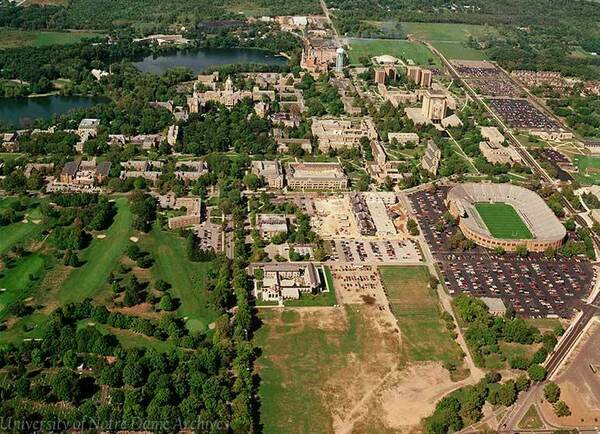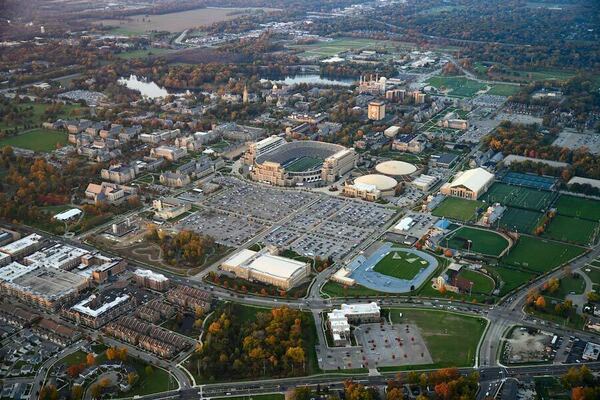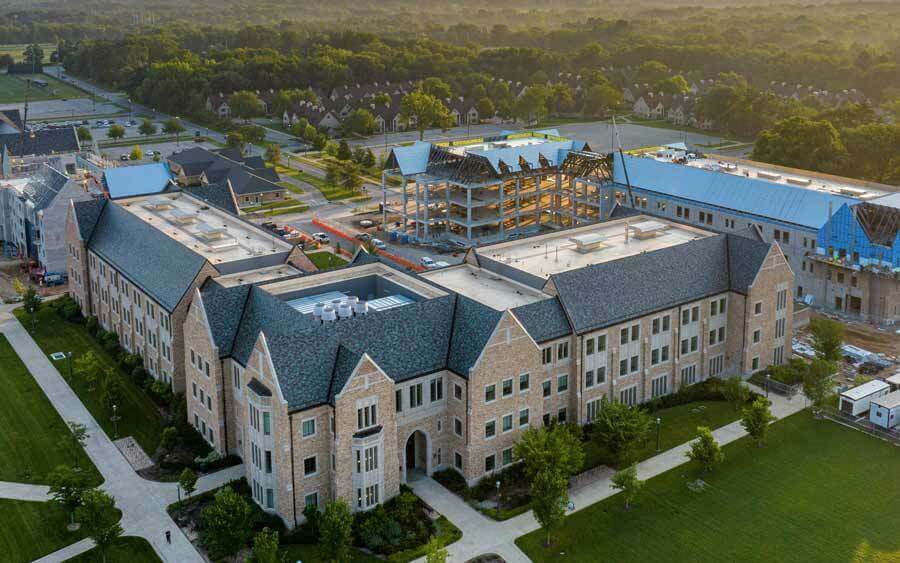- Home ›
- Notre Dame 2033: A Strategic Framework ›
- Part I: Where Notre Dame has been and where it is now
Part I: Where Notre Dame has been and where it is now

If we could return to Notre Dame in 1990, much would be familiar. Founded by Rev. Edward F. Sorin, C.S.C., and the Congregation of Holy Cross in 1842, the University has been among the most national of American colleges and universities since the mid-20th century. It attracted students from across the United States, typically graduates of Catholic high schools drawn to Notre Dame as a leading Catholic university. The University’s wider reputation derived from a tradition of excellent undergraduate education and the publicity given to the University’s athletic teams, with their successes on and off the playing fields. 2
The leadership was unusually stable, with one president, Rev. Theodore M. Hesburgh, C.S.C., serving from 1952 to 1987 and a second president, Rev. Edward A. Malloy, C.S.C., serving from 1987 to 2005.
The dedication of our alumni was striking. As early as the 1960s, alumni and friends provided matching funds to surpass the largest grant in the University’s history, from the Ford Foundation. This collective effort began with a televised address to alumni clubs in 175 cities. Notre Dame still claims more such clubs (supported by alumni, parents, and friends) than any other university: 224 in the United States and 42 outside the United States. 3
Notre Dame frequently reaffirmed its commitment to its Catholic mission, even if the implications of that mission for the curriculum and faculty and student recruitment provoked continual discussion. Many of the University’s strongest academic programs in 1990, typically in the humanities and humanistic social sciences in areas ranging from medieval studies to Irish literature to Latin American politics, had developed out of a conscious affinity with Catholicism as an intellectual tradition. Benefactors endowed faculty positions, along with related library collections. Notre Dame faculty, unsurprisingly, wrote some of the most considered reflections on how a university might combine Catholicism with high intellectual standing. 4
Our institutional commitment to teaching and the reputation of our undergraduate education was superior. Students won national fellowships, volunteered for full-time service after graduation, found employment with major firms, and were admitted to selective medical, law, and graduate schools.
The single-sex residential system, anchored by the presence of Holy Cross priests and brothers, and, since the 1970s, women religious and laypeople, signaled the importance of character and formation, not simply academic accomplishment. At its best, it cultivated a profound sense of community. The first question asked (even now) when two Notre Dame graduates meet each other for the first time is: “What dorm did you live in?”
Much was also different. Graduate and professional programs were typically small. Law (1869) and Architecture (1898) had long and worthy histories but modest national influence. The University did not grant its first master’s degrees in business administration until 1969. Almost all doctoral programs ranked below competitors in the Big 10, the University of California system, the Ivy League, and institutions such as Stanford, the University of Chicago, Duke, and Johns Hopkins. Programs in science and engineering — with a few exceptions such as math, nuclear physics, and vector biology — were poorly ranked and hindered by dated equipment and facilities. No dedicated office of research existed until 2004 and few research programs attracted major federal, foundation, or corporate funding. Administrators encouraged faculty to conduct research, but struggled to find the resources (and create the time) to support that research.
Our financial situation was stable if unpromising. The wonder is how much was accomplished with so little. Only in the 1980s did faculty salaries at Notre Dame begin to creep above the median for major research universities. 5 Financial aid for undergraduates — excepting Reserve Officers’ Training Corps (ROTC) programs and athletic scholarships — was insufficient, and admitted students often reluctantly chose to enroll at low-cost state institutions or private colleges and universities with stronger aid packages.
The inability to meet demonstrated financial need inhibited efforts to diversify (in economic and ethnic terms) an overwhelmingly white and middle-class undergraduate student body. Notre Dame first admitted women as undergraduates in 1972, roughly at the same moment as Harvard, Dartmouth, Princeton, and other once all-male institutions. As late as 1990, though, women numbered only 37 percent of the undergraduate student body (and a small percentage of faculty and administrators). The institution at all levels grappled with forging an inclusive community in a historically male, predominantly white milieu.
Core characteristics of the Notre Dame of 1990 endure, notably the emphasis on undergraduate education and the residential experience, and our commitment to the University’s Catholic mission. Undergraduate education has been deepened by opportunities for research (including a focus on senior theses, experiential learning, and projects), community engagement, and study abroad options. Division I athletics still provides a focal point for students and alumni, but athletic successes stretch well beyond the revenue-producing sports of football and men’s basketball to the full complement of women’s sports. Women’s basketball, men’s and women’s fencing, and lacrosse have recently won national championships. Surveys of graduating seniors record extraordinarily high rates of satisfaction with the education they received and the community they found at Notre Dame, although, notably, satisfaction with the community is lower for first-generation college students and underrepresented minorities. Continuity in leadership remains significant: three presidents since 1952 with Rev. John I. Jenkins, C.S.C., as president since 2005, six provosts since 1970, five executive vice presidents since 1957, and long tenures for many deans.
The most important changes were financial. Financial acumen and best-in-class fundraising and endowment management combined to elevate our endowment to the seventh largest for private universities in 2022. The most recent comprehensive fundraising campaign was the largest ever by any private university without a medical school. The percentage of alumni who donate each year to the University has consistently ranked in the top three, along with Princeton and Dartmouth, institutions with significantly smaller alumni populations. The percentage of parent donors who are not alumni is also one of the top three in the country. 6
Returns on the endowment over a 25-year period ranked among the highest of all universities. In 1990, Notre Dame’s endowment was just over $600 million and the payout covered 10 percent of the University’s annual budget; it is now roughly $17 billion and the payout covers 37 percent of a much larger budget. In 1990, the endowment was smaller than the endowments of the University of Chicago, Columbia, Cornell, Emory, and Northwestern; today it is larger than the endowment at each of these institutions. 7
Our financial successes — made possible by the loyalty and generosity of the American Catholic community from which Notre Dame draws most of its students and supporters — enabled three notable transformations:

The first transformation was the most visible: an astonishing number of buildings constructed between 1990 and 2023. These facilities reconstituted the physical campus and allowed the University to develop more extensive research programs for faculty, undergraduates, and graduate students. Board of Trustee policies mandated that the funding for these buildings come out of benefaction, not tuition dollars, and their design and location followed a rigorously reviewed campus master plan. The largest facilities were in Science and Engineering, including a major new facility bolstering nanotechnology and energy research, a state-of-the-art teaching facility, and two equally sizable buildings (one now underway) dedicated to interdisciplinary investigation in the life sciences and bioengineering. Law, Business, and Architecture opened impressive new facilities. Music faculty and students occupied the first facility constructed for music since the 19th century. The University completed the first two buildings dedicated to the social sciences in Notre Dame’s history and a building housing the Keough School of Global Affairs. A performing arts center opened in 2004. An art museum will open in November 2023.
The total square feet on the campus dedicated to academic purposes doubled between 1990 and 2022, from 2.5 million to 5 million. Few, if any, private research universities expanded their physical plant at such a velocity. This number does not include a new student center or a new graduate student housing complex. Or the building of 10 undergraduate residence halls (with one more under construction), in part to relieve overcrowding but even more to deepen undergraduate community life.
The second transformation was in the makeup of the undergraduate student body. Skeptical observers had once wondered whether Notre Dame’s undergraduate program could continue to attract the most talented Catholic high school students after these students were admitted in large numbers to leading secular universities. 8
Notre Dame passed this market test. In 1990, half of the high school seniors who applied to Notre Dame were accepted and just under half of those students matriculated. In 2022, by contrast, 13 percent of a much larger number of students who applied were accepted and 60 percent of those students matriculated. Of those who report test scores, 54 percent of students admitted in the class of 2022 were in the top 1 percent of all students. Almost 90 percent were in the top 5 percent. 9
What accounts for this evolution? Much rested on the decision of the Board of Trustees to establish as a goal meeting full demonstrated financial need for undergraduate students. Notre Dame is now one of roughly 50 colleges and universities with both need-blind admissions for domestic undergraduate applicants and a commitment to meet demonstrable financial need. Significant pressure still exists on the children of middle-class families hoping to attend Notre Dame, especially if they have siblings. These admitted students and their parents often weigh the cost of an education at Notre Dame versus merit scholarships and more affordable options elsewhere.
Still, despite the steadily rising cost of a Notre Dame education, the indebtedness of Notre Dame students upon graduation has gone down, not up, in the last decade because of strong financial aid packages. This same focus has allowed for the recent sharp increase in Pell-eligible students (students whose families typically have incomes of less than $65,000 per year) and first-generation college students. These students now number more than 20 percent of the incoming class of undergraduate first-year students. The cumulative result is a 2023 undergraduate student body more academically accomplished and more diverse along almost every measure than any student body in the University’s history.
The third transformation has been the growth in the range and quality of academic research conducted at the University. A fundamental question at Notre Dame was once: “Should we become a research university?” The more relevant question now is: “How great a research university can we be?” Leading private research universities are undeniably resource intensive. But they undeniably shape our world. They educate a disproportionate number of local, national, and global leaders, and research conducted at these institutions plays a pivotal role in addressing enduring problems and contemporary challenges.
At Notre Dame, external research funds brought to the University grew from $78 million in 2004 to $281 million in 2022. This rate of increase was among the fastest for private research universities. When dollars received by medical schools at other universities are removed from their totals, a meaningful comparison since Notre Dame does not have a medical school, Notre Dame compares well with most — although not all — of the most competitive private research universities. More than any other single factor, this expansion of research drove Notre Dame’s admittance to the AAU.

Footnotes
2. ^ John Underwood, “Casting a Special Light,” Sports Illustrated (January 10, 1983).
3. ^ The Ford Foundation offered Notre Dame $12 million but only if the University raised $24 million. The University raised $32 million. Thomas E. Blantz, C.S.C., The University of Notre Dame: A History (Notre Dame, 2020), 405–407.
4. ^ For example, Theodore M. Hesburgh, C.S.C., ed., The Challenge and Promise of a Catholic University (Notre Dame, 1994); Alasdair Macintyre, “Catholic Universities: Dangers, Hopes, Choices,” in Higher Learning and Catholic Traditions, ed. Robert E. Sullivan (Notre Dame, 2001), 1–21; Robert E. Sullivan, “The University of Notre Dame’s catholic and Catholic future: professors, teaching and scholarship” (2007); Mark W. Roche, The Intellectual Appeal of Catholicism and the Idea of a Catholic University (Notre Dame, 2003); Christian Smith and John C. Cavadini, Building Catholic Higher Education: Unofficial Reflections from the University of Notre Dame (Eugene, OR, 2014).
5. ^ William J. Baumol and Maryse Eymonerie. “Rising Costs and the Public Institutions: The Annual Report on the Economic Status of the Profession 1969–1970,” AAUP Bulletin 56, no. 2 (1970): 174–239, https://doi.org/10.2307/40224518. W. Lee Hansen and Maryse Eymonerie, “Regressing into the Eighties: Annual Report on the Economic Status of the Profession, 1979-80,” Academe 66, no. 5 (1980): 260–320, https://doi.org/10.2307/40249415. Notre Dame Fact Book 1969–70: 26–34, https://data.nd.edu/reports/faculty-salaries.
6. ^ Council For Aid to Education, VSE-CAE Voluntary Support of Education Report.
7. ^ National Association of College and University Business Officers, Historic Endowment Study Data.
8. ^ Christopher Jencks and David Riesman, The Academic Revolution (Garden City, 1968), 59.
9. ^ The percentage of students who report test scores is dropping in a test-optional environment;
44 percent of Notre Dame applicants reported their test scores in the last admissions cycle.
Part I: Where Notre Dame has been and where it is now